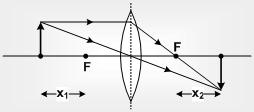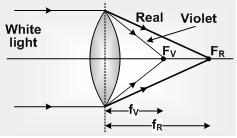Lens
(i) Lens is a transparent medium bounded by two refracting surfaces, such that at least one surface is curved. Curved surface can be spherical, cylindrical etc.
(ii) Lenses are of two basic types convex which are thicker in the middle than at the edges and concave for which the reverse holds.

(iii) Principal focus : We define two principal focus for the lens. We are mainly concerned with the second principal focus (F). Thus wherever we write the focus, it means the second principal focus.
First principal focus : An object point for which image is formed at infinity.

Second principal focus : An image point for an object at infinity.

Focal Length, Power and Aperture of Lens
Focal length (f) : Distance of second principal focus from optical centre is called focal length
fconvex –> positive, fconcave –> negative, fplane –> ∞
Aperture: Effective diameter of light transmitting area is called aperture. Intensity of image ∝ (Aperture)2
Power of lens (P): Means the ability of a lens to deviate the path of the rays passing through it. If the lens converges the rays parallel to the principal axis its power is positive and if it diverges the rays it is negative.
Power of lens P = 1/f(m) = 100/f(cm); Unit of power is Diopter (D)
Pconvex –> positive, Pconcave –> negative, Pplane –> zero.



Lens Formula
Lens formula: The expression which shows the relation between u, v and f is called lens formula.
1/f = 1/v – 1/u
Lens maker formula: If R1 and R2 are the radii of curvature of first and second refracting surfaces of a thin lens of focal length f and refractive index µ (w.r.t. surrounding medium) then the relation between f, µ, R1 and R2 is known as lens maker formula.
1/f = (µ – 1) {1/R1 – 1/R2}
Magnification
The ratio of the size of the image to the size of object is called linear magnification.
(i) Transverse magnification : m = I/O = v/u = f/f+u = f–v/f (use sign convention while solving the problem)
(ii) Areal magnification : ms = Ai/Ao = m2 = (f/f+u)2
(Ai = Area of image, Ao = Area of object)
Relation between object and image speed: If an object moves with constant speed (Vo) towards a convex lens from infinity to focus, the image will move slower in the beginning and then faster.
Also V1 = (f/f+u)2.Vo
Newton Formula
If the distance of object (x1) and image (x2) are not measured from optical centre, but from first and second principal foci then Newton's formula states f2 = x1x2

Lens Defects
Chromatic aberration: Image of a white object is coloured and blurred because µ (hence f) of lens is different for different colours. This defect is called chromatic aberration.
µv > µR so fR > fV

Mathematically chromatic aberration = fR – fv = ωfy
ω = Dispersive power of lens.
fy = Focal length for mean colour √fRfv
Removal: To remove this defect i.e. for Achromatism we use two or more lenses in contact in place of single lens.
Mathematically condition of Achromatism is : ω1/f1 + ω2/f2 = 0
or ω1f2 = –ω2f1
Spherical aberration:
Inability of a lens to form the point image of a point object on the axis is called Spherical aberration.

In this defect all the rays passing through a lens are not focused at a single point and the image of a point object on the axis is blurred.
Removal: A simple method to reduce spherical aberration is to use a stop before and infront of the lens. (but this method reduces the intensity of the image as most of the light is cut off). Also by using plano-convex lens, using two lenses separated by distance d = F – F', using crossed lens.
